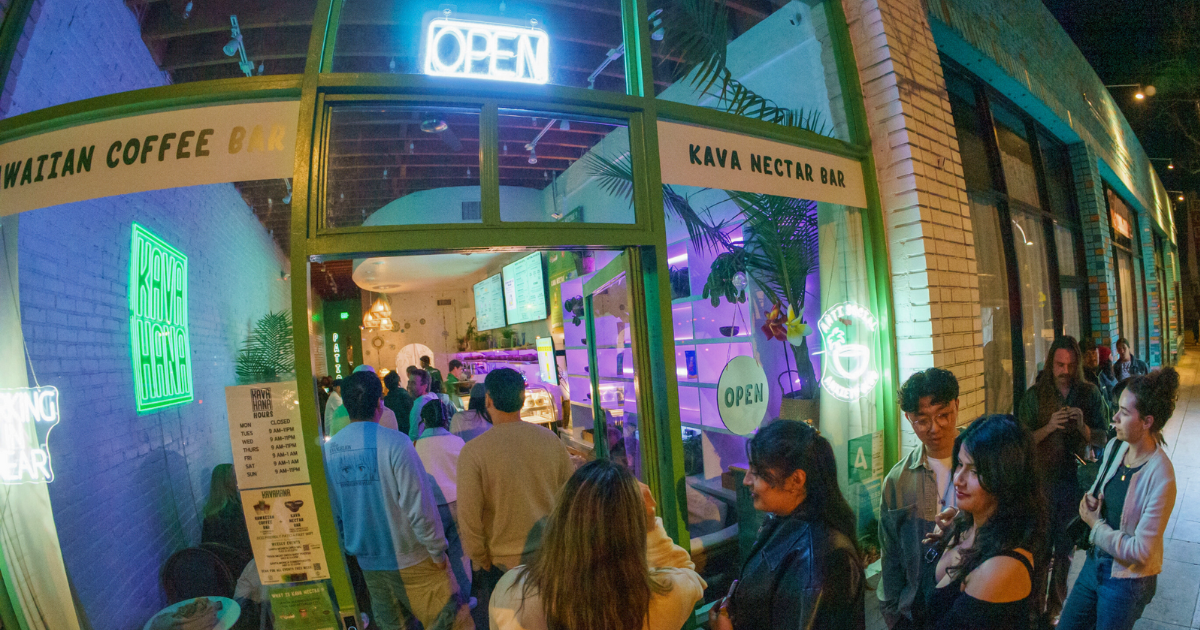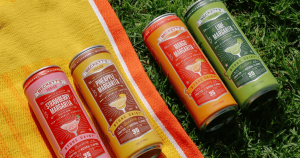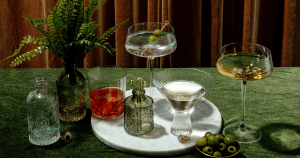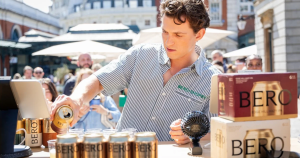Partner Content: Kavahana
At Kavahana, a kava café just blocks from the beach in Santa Monica, co-founders Hannah Wilen and Neil Bhatia are reshaping what we believe about ritual, relaxation, and alcohol alternatives.
What started as a college dorm room routine has evolved into a culturally rooted café and carefully sourced product line that’s gaining traction across demographics. In this conversation, Wilen shares how her experiences have helped build something that feels both ancient and radically new.
Dry Atlas: What first drew you to kava? And when did you realize it could become more than a personal interest?
Hannah Wilen: I’ve lived with anxiety most of my life, and about ten years ago I discovered kava while researching natural ways to feel more at ease. I visited a kava bar near my college, and it was the first thing that helped me feel present and in my body without sedation. To me, it wasn’t really an alcohol alternative. It was a mental health drink.
I started making kava in my dorm the traditional way, with a mesh strainer bag. It became a relaxing ritual, like making coffee in the morning or pouring a glass of wine at night. At the time, I wasn’t thinking about business. I’d simply always been interested in herbal medicine and wellness, even if I didn’t label it that way.
Later, when Neil and I had worked other jobs and started separate startups, we both developed a strong connection with the kava plant, its deep history, and natural wellness in general. We kept wondering why kava wasn’t bigger.
DA: Were there any pivotal experiences that inspired you to build a business around kava specifically?
HW: It wasn’t one big realization—more like a series of small nudges. One was the first time I went to a kava bar. It looked like a bar, but it had no alcohol. It was open at 7 AM. It didn’t fit into any category. I’ve always liked the low-pressure vibe of coffee and boba shops. The kava bars I visited felt social but not rowdy, relaxed but not sleepy.
When I moved back to LA, I looked for a place like that and found nothing. For a city with every trendy drink, it felt like a gap. I kept wishing there was a spot I could go to that wasn’t a bar or a coffee shop.
After COVID, that feeling intensified. People feel more disconnected now, and tech and AI are woven into daily life. I studied engineering and worked in tech, and while I see the potential, it feels just as important to create spaces centered on human connection. Kava has always done that.
DA: Kava has deep cultural roots in the South Pacific. How do you balance honoring that tradition while introducing kava to a broader audience?
HW: My co-founder Neil has Indo-Fijian family, and kava is Fiji’s national drink. It also connects cultures in Vanuatu, Samoa, Tonga, and Hawaii. It’s used socially, ceremonially, and in daily life, which makes it really special.
Our kava nectar comes from small farms in Vanuatu. Kava is one of the top exports in both Vanuatu and Fiji and is vital to their economies. Most people we’ve met want more people to experience kava, as long as it’s done with care.
DA: You’ve launched both a physical café and a DTC product line. What was the thinking behind starting with a brick-and-mortar presence?
HW: When Neil and I started Kavahana, we always envisioned a physical space. The DTC side came later. We began in summer 2023, popping up at underground raves in LA, serving kava with flavors like ube and vanilla coconut for sober ravers. Then we did farmers markets, and eventually opened right by the beach in Santa Monica.
We wanted to make kava more accessible, and that’s when we started developing our product line, Kava Nectar. Around the same time, we found the perfect spot for our first location.
The bar gives people the full experience. They can talk to our bartenders, feel the effects, and meet like minded people. Even though our online business has grown, the bar is the heart of everything. Watching someone smile after their first sip is what gives me the most satisfaction.
DA: What makes Kavahana’s in-store experience different from a traditional café?
HW: It’s a busy café with a relaxed vibe. We open in the morning and stay open until 1 AM on weekends, which makes us one of the only late-night, non-alcoholic spots on the Westside.
People come here to work, meet friends, go on dates, or just hang out. It has a neighborhood feel but also a full brand experience. We serve our Kava Nectar, along with Kona coffee, hojicha, and matcha.
We host weekly events like comedy and open mic nights, and many regulars come back often. This year, we were named Santa Monica’s Most Loved New Business, which meant a lot.
DA: Let’s talk about your Kava Nectar products. How did the idea come about, and what makes them different from traditional kava?
HW: Kava Nectar came from wanting to make kava more approachable while keeping its full-spectrum benefits. It’s made by cold-pressing fresh kava root and drying the juice into powder. No extracts, sugar, or fillers. Just natural kava.
It’s earthy, like traditional kava, and we stand behind that. We’re offering a high-quality base that you can enjoy your own way.
Kava plants take years to grow, and only the root is used. Cutting corners dilutes the effects, and kava is all about how it makes you feel. One of our most common reviews is, “Tastes like sh*t, feels amazing.” That always makes me laugh.
DA: What misconceptions do people still have about kava, and how are you working to change them?
HW: The biggest one is liver damage. That started in the early 2000s when a pharmaceutical company in Germany released a drug with kava as one ingredient. The drug caused harm, but kava got blamed.
Interest in kava dropped. Years later, it turned out kava wasn’t the problem. In over 3,000 years of traditional use, there is no record of liver issues. New research even suggests kava may support liver health.
People also think kava might be addictive. But it doesn’t create dependency. In fact, the more you drink it, the less you might need to feel the same effect. That’s called reverse tolerance.
DA: How do you think kava compares to other adaptogenic beverages?
HW: I think kava is kind of the original adaptogen, and one of the few you can actually feel. A lot of adaptogenic drinks are great in theory, but hard to gauge. Kava is different. The effects are real.
The hurdles have always been taste and sourcing. It takes years to grow, and quality matters. But now that better formats like Kava Nectar exist, I think it’s on its way to becoming mainstream.
DA: What role can or should kava play in the mindful drinking movement?
HW: Kava isn’t just an alcohol alternative. That’s what makes it a great fit for mindful drinking. You can drink it any time of day, depending on how you want to feel.
There are different cultivars of kava with different effects, some uplifting, some calming. At our bar and online, we offer three, which are all proprietary blends of kava cultivars: Classic, Balance, and Relax. Classic is great for socializing, Balance for daytime focus, and Relax for winding down.
Kava has in-the-moment effects, but also long-term benefits. That’s what mindful drinking means to me, and kava fits in naturally.
DA: How has the reception been from people who are totally new to kava? Are there certain audiences that “get it” right away?
HW: Most people don’t get it immediately, and that’s okay. It’s not mainstream yet. But once it clicks, they tend to stick with it. We have a high return customer rate, and we put a lot of effort into helping people understand how to use it.
At the bar, we see mostly Gen Z and Millennials who want a fun alternative to alcohol. Online, our audience skews older and is more focused on wellness and routine. Most customers are new to kava, which is exactly who we made Kava Nectar for.
DA: Do you see kava becoming more of a mainstream presence in bars, restaurants, or even homes? What’s missing for that to happen?
HW: Totally. But for that to happen, quality and quantity need to align. If someone tries weak kava and doesn’t feel anything, they might never try it again. That first experience really counts.
Reverse tolerance also means some people might not feel it at first. That’s why education is key. It’s one of the reasons we opened the bar—to guide people in person.
There’s a bit of a kava shortage right now, but we work closely with partners to bring in high-quality root. I think it’s great more companies are exploring kava, because it builds awareness and helps the whole category.
DA: Fast-forward five years. What does success look like for Kavahana and for kava culture more broadly in the U.S.?
HW: Five years from now, I’d love for Kavahana to be a brand people recognize. Not just because of what we’re doing, but because kava itself has become more understood and accepted.
I want someone to walk into a restaurant or grocery store and see kava on the menu next to coffee, tea, or wine, and actually know what it is. And I hope by then, the biggest misconceptions about kava are behind us. Various myths have held the category back for too long, and they’re just not supported by the evidence or the way people use kava today.
This interview has been edited for length and clarity.






